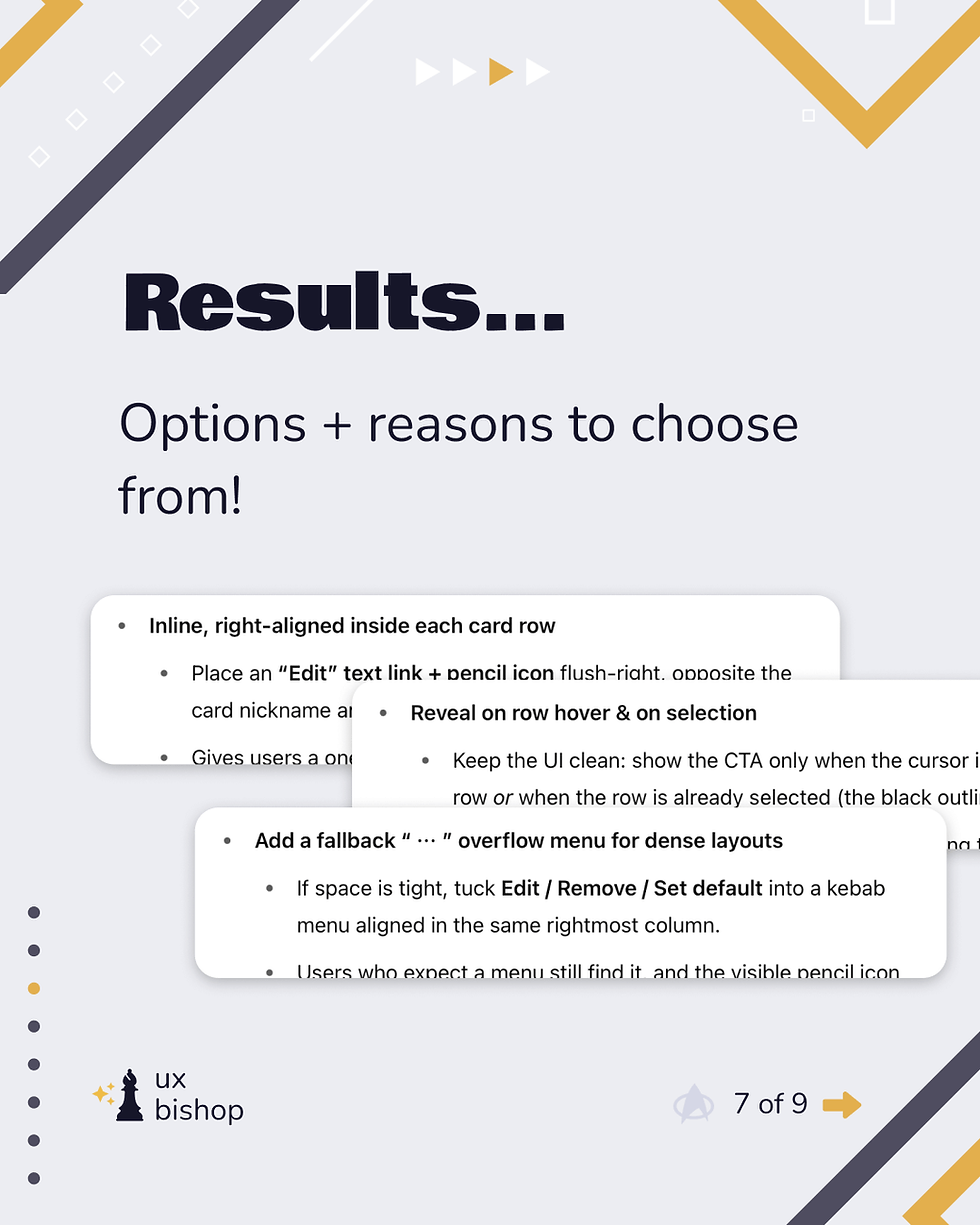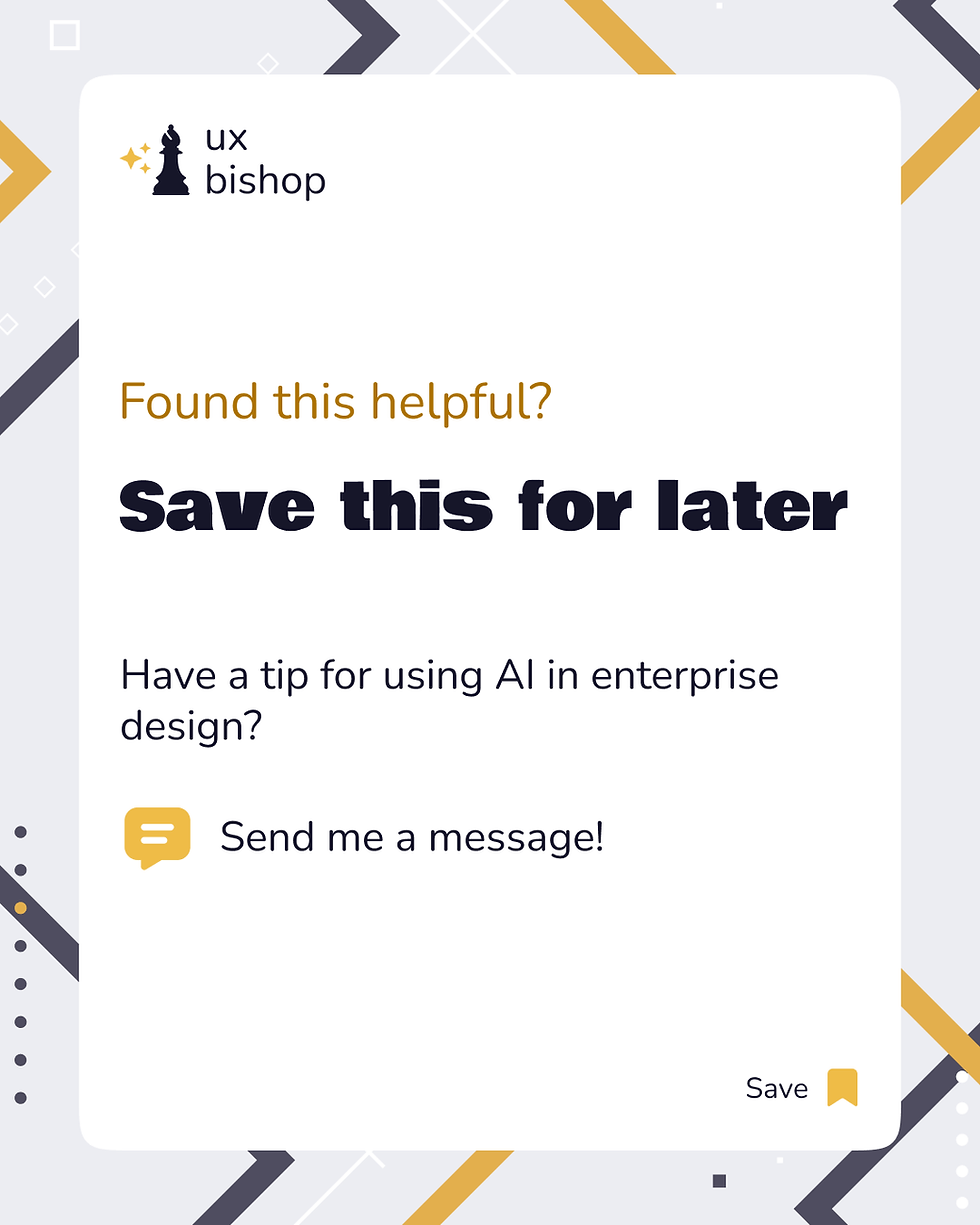Mentoring AI: Prompting AI Like a Design Lead
- architette
- Aug 7
- 4 min read
Updated: Aug 6

TLDR version:
When AI is treated like a task-runner, you’ll get generic, misaligned output. But when you prompt with context, structure, constraints, and clarity... you set your AI intern up for success.
In this edition of "Mentoring AI", I explore how a simple prompt went wrong, what the AI did, and how rewriting the prompt as a UX lead dramatically improved the results.
What you'll learn in this post:
Why prompting AI is a form of design leadership
How vague prompts lead to usability issues
A framework for writing smarter UX prompts
A side-by-side breakdown of original vs. revised results
Real-world insights for designers working in enterprise environments
Prompting AI Is Design Leadership
If you’re using AI to support your UX workflow, you’ve likely run into this: you give a tool a quick and simple task and the result technically fulfills the prompt, but fails the design.
Sound familiar? That’s because prompting AI isn't just about writing commands. It’s about communicating design intent with clarity and mentorship.
This is the core principle behind what I call the Mentoring AI... a series where I explore real examples of guiding AI through better prompts. This post breaks down one of those moments in action.

The Setup: A CTA Prompt Gone Wrong
The goal was to add a clear, usable way for users to edit payment details in their wallet. I asked ChatGPT to add a call-to-action to the cards in the wallet experience so users could edit them.


When working quickly, this prompt seemed reasonable. But what I got back was a perfect example of the limits of vague direction.
The Output: Every Card Got Every Button
The AI-generated design added a full set of action buttons to every card. Every. Single. One. 😅

This output wasn’t wrong... but it wasn’t useful either. It ignored hierarchy, cluttered the interface, and broke design system conventions. In other words: the AI did exactly what I asked, not what the user needed.
Diagnosing the Problem
The problem wasn’t with AI. It was my quick prompting.

❌ I didn’t give constraints
❌ I didn’t define an expected output format
❌ I didn’t define AI’s role as a UX designer
This is where prompt writing and design leadership intersect. When we treat AI like a junior teammate, it’s our responsibility to guide, not just delegate.
The Rewrite: Prompting Like a UX Lead
To course-correct, I rewrote the prompt using a structured format I now recommend to anyone prompting AI for UX work:
Prompt Structure
Role: Who is the AI acting as?
Task: What’s the action?
Context: What’s the situation or screen behavior?
Constraints: What rules must it follow?
Format: How should the output be returned?

Example Revised Prompt:
Imagine you are a UX designer. Analyze the attached wallet experience and suggest a place where we can add a call-to-action to the cards that would help users confidently edit the payment details for the card of their choice. Focus on desktop web usability, and bullet point your suggestions along with rationale behind it.
By defining the role and constraints, I taught AI to make intentional design choices... not just decorate every card with buttons.
Results That Respected Design Logic
Once I prompted AI using this more structured approach, the difference was clear!

The new output included:
Placement logic tied to user interactions (e.g., reveal on hover)
Context-aware recommendations based on typical user behavior
Fewer, more targeted buttons based on priority
Justifications for each suggestion (why it improves usability)
AI went from overdoing it to making informed, usable, and system-aligned decisions.
Why This Works: AI as Intern, You as Mentor
When we treat AI like a tool, it gives us output. When we treat AI like a junior designer, it gives us insightful output.

Framing your prompt through a design leadership lens allows you to:
Clarify expectations
Reduce rework
Drive output that aligns with real-world UX constraints
Build AI feedback loops into your design process
This is especially useful for enterprise teams where design systems, legal compliance, and accessibility standards need to be enforced from the beginning.
Recap: Mentoring AI Takeaways
If you’re starting to use AI in your design process, here’s how to avoid the trap of “bad output”:
Start with your intent, not just your task
Define a clear role for AI to play (UX designer, copywriter, accessibility auditor, etc.)
Use structured prompting that mirrors how you’d guide a junior team member
Provide context, constraints, and expected output format
Treat AI suggestions like drafts... your job is still to curate, correct, and elevate
Final Thoughts: Designing the Prompts That Design the Work
In enterprise UX, time is limited and AI is becoming a bigger part of our workflows. That makes prompt literacy a critical UX skill... one that blends communication, mentorship, and systems thinking.
"Mentoring AI" isn’t just about fixing bad AI outputs. It’s about leveling up how we collaborate with AI, just like we would with teammates.
If you’re working in a corporate UX environment and exploring how to integrate AI into your process, I hope this breakdown offers a tactical starting point.
Have prompt frameworks of your own? Tried this method and seen results? I’d love to hear from you!
… and before you ask, yes… I wrote this post with the help of AI but heavily edited just about every line so it is more of myself. 😉

Disclaimer: The thoughts shared in this blog are solely my own and do not represent the perspectives of my professional relationships or clientele.
Comments